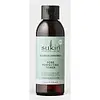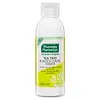What's inside
What's inside
 Key Ingredients
Key Ingredients

 Benefits
Benefits

 Concerns
Concerns

 Ingredients Side-by-side
Ingredients Side-by-side

Water
Skin ConditioningGlycerin
HumectantAloe Barbadensis Leaf Juice
Skin ConditioningCydonia Oblonga Leaf Extract
Skin ConditioningCamellia Sinensis Leaf Extract
AntimicrobialZingiber Officinale Root Extract
MaskingMentha Piperita Leaf Extract
Skin ConditioningMelaleuca Alternifolia Leaf Oil
AntioxidantEucalyptus Citriodora Oil
MaskingRosmarinus Officinalis Leaf Oil
MaskingLavandula Angustifolia Oil
MaskingCaprylyl/Capryl Glucoside
CleansingSodium Cocoyl Glutamate
CleansingSalicylic Acid
MaskingGlyceryl Caprylate
EmollientPolyglyceryl-6 Oleate
EmulsifyingSodium Surfactin
CleansingSorbic Acid
PreservativeSodium Hydroxide
BufferingBenzyl Alcohol
PerfumingLimonene
PerfumingLinalool
PerfumingWater, Glycerin, Aloe Barbadensis Leaf Juice, Cydonia Oblonga Leaf Extract, Camellia Sinensis Leaf Extract, Zingiber Officinale Root Extract, Mentha Piperita Leaf Extract, Melaleuca Alternifolia Leaf Oil, Eucalyptus Citriodora Oil, Rosmarinus Officinalis Leaf Oil, Lavandula Angustifolia Oil, Caprylyl/Capryl Glucoside, Sodium Cocoyl Glutamate, Salicylic Acid, Glyceryl Caprylate, Polyglyceryl-6 Oleate, Sodium Surfactin, Sorbic Acid, Sodium Hydroxide, Benzyl Alcohol, Limonene, Linalool
Water
Skin ConditioningHamamelis Virginiana Water
AstringentPolysorbate 20
EmulsifyingSodium PCA
HumectantGlycerin
HumectantSorbitol
HumectantMelaleuca Alternifolia Leaf Oil
AntioxidantLactic Acid
BufferingPotassium Sorbate
PreservativeSodium Lactate
BufferingAllantoin
Skin ConditioningLavandula Angustifolia Oil
MaskingAloe Barbadensis Leaf Juice Powder
Skin ConditioningLimonene
PerfumingLinalool
PerfumingIngredients Explained
These ingredients are found in both products.
Ingredients higher up in an ingredient list are typically present in a larger amount.
Glycerin is already naturally found in your skin. It helps moisturize and protect your skin.
A study from 2016 found glycerin to be more effective as a humectant than AHAs and hyaluronic acid.
As a humectant, it helps the skin stay hydrated by pulling moisture to your skin. The low molecular weight of glycerin allows it to pull moisture into the deeper layers of your skin.
Hydrated skin improves your skin barrier; Your skin barrier helps protect against irritants and bacteria.
Glycerin has also been found to have antimicrobial and antiviral properties. Due to these properties, glycerin is often used in wound and burn treatments.
In cosmetics, glycerin is usually derived from plants such as soybean or palm. However, it can also be sourced from animals, such as tallow or animal fat.
This ingredient is organic, colorless, odorless, and non-toxic.
Glycerin is the name for this ingredient in American English. British English uses Glycerol/Glycerine.
Learn more about GlycerinLavandula Angustifolia Oil is more commonly known as lavender essential oil. It is considered a fragrancing ingredient.
Lavender imparts a famous scent. While the smell is lovely, this ingredient and may sensitize skin in topical products. This is because about 85% of the oil is made up of linalool and linalyl acetate.
When exposed to air, these two compounds become strong allergens. This ingredient exhibits cytotoxicity at low concentrations; amounts of 0.25% have been shown to damage skin cells.
A study from Japan found this ingredient caused lavender sensitivity after widespread exposure.
Lavender essential oil has some antimicrobial, antibacterial, and anti-inflammatory properties. However, the cons of this ingredient may outweight the pros.
More research is needed to confirm lavender essential oil's effects when used in aromatherapy.
Lavandula Angustifolia is known as the English Lavender and famous for creating purple fields in Provence, France.
Learn more about Lavandula Angustifolia OilLimonene is a fragrance that adds scent and taste to a formulation.
It's found in the peel oil of citrus fruits and other plants such as lavender and eucalyptus. The scent of limonene is generally described as "sweet citrus".
Limonene acts as an antioxidant, meaning it helps neutralize free radicals.
When exposed to air, oxidized limonene may sensitize the skin. Because of this, limonene is often avoided by people with sensitive skin.
The term 'fragrance' is not regulated in many countries. In many cases, it is up to the brand to define this term. For instance, many brands choose to label themselves as "fragrance-free" because they are not using synthetic fragrances. However, their products may still contain ingredients such as essential oils that are considered a fragrance.
Learn more about LimoneneLinalool is a fragrance and helps add scent to products. It's derived from common plants such as cinnamon, mint, citrus, and lavender.
Like Limonene, this ingredient oxidizes when exposed to air. Oxidized linalool can cause allergies and skin sensitivity.
This ingredient has a scent that is floral, spicy tropical, and citrus-like.
Learn more about LinaloolThis tea tree oil comes from the leaves of the Tea Tree plant. Tea tree oil has antioxidant, anti-inflammatory, and antimicrobial properties.
According to the book Journal of Profiles of Drug Substances, tea tree helps in reducing acne-causing bacteria such as Propionibacterium acnes. This is due to the Terpinen components of tea tree oil.
Tea tree may cause sensitivity and irritation for some people. This oil naturally contains fragrance such as linalool and limonene.
However, research shows irritation usually occurs when using pure tea tree oil and not in cosmetic products.
Tea tree oil was found to help relieve the symptoms of psoriasis in one study.
Tea tree oil is toxic when ingested. Another study showed it to caused damage to the nervous system of dogs and cats when applied to their skin or given orally.
Learn more about Melaleuca Alternifolia Leaf OilWater. It's the most common cosmetic ingredient of all. You'll usually see it at the top of ingredient lists, meaning that it makes up the largest part of the product.
So why is it so popular? Water most often acts as a solvent - this means that it helps dissolve other ingredients into the formulation.
You'll also recognize water as that liquid we all need to stay alive. If you see this, drink a glass of water. Stay hydrated!
Learn more about Water